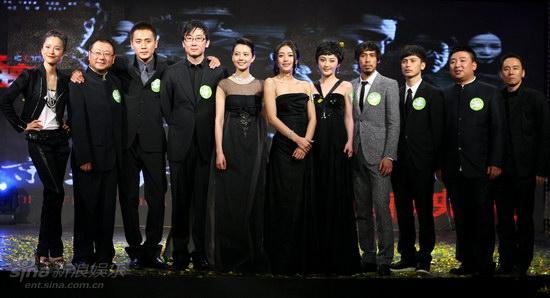|
 |
|
Director Lu Chuan (L-4) and crew members of City of Life and Death pose for group photos at the premiere ceremony on April 16, 2009 in Beijing (Sina.com) |
With an average age of 35, Chinese filmmakers, led by talented director Lu Chuan, have shown their own understanding of the Nanjing Massacre more than 70 years ago as City of Life and Death premieres in Beijing on Thursday--one week ahead of its global release.
"We don't want that when people think of that period of history, only some dry figures come up to their mind. We hope people will see some particular faces and their expressions and characteristics," said Lu at the premiere ceremony.
City of Life and Death focuses on Chinese soldiers and civilians' fight against invaders before and after the Nanjing Massacre in 1937.
It took four years and cost 80 million yuan ($11.7 million) to finish the work, whose original Chinese title is Nanking! Nanking! More than 20,000 college students volunteered in the film.
Cinematographer Cao Yu had a solid working relationship with Lu back in Kekexili: Mountain Patrol (2004). The 34-year-old Cao shot the entire film in black-and-white to achieve a documentary-like style.
"During the four years after making Kekexili, we were trying to find a more powerful and massive subject ... We chose black and white because we want to revive that particular time of history as best as we can and bring out the solid atmosphere."
When he visited a museum for project research, Cao said he was overwhelmed by the steadiness and strength that showed through the eyes of the Chinese people before death in some rare pictures taken by Japanese journalists.
"I can see the fortitude and strength in their eyes. That's what we wanted to convey through a film," said Cao.
Director Lu also stressed that the theme of the film was the resilient spirits of Chinese people in danger--unlike many massacre films that focus on the weakness and hopelessness of victims.
The 38-year-old Lu is considered one of the most talented young directors in the country and won global acclaim for Kekexili: Mountain Patrol.
The film, based on a true story of volunteers who patrolled in the Qinghai-Tibetan highland and fought against killers of rare Tibetan antelopes, won Best Film and Special Jury Prize at the Tokyo Film Festival and a Special Mention award in Berlin.
To present a realistic Nanjing city in 1937, it is said that the crew at the makeup department had to do more than 2,000 figurants in one day, not ignoring details such as a loose button or the mud inside their fingernails.
On December 13, 1937, the invading Japanese army occupied Nanjing and launched a six-week massacre. Chinese records show more than 300,000 people, not only disarmed soldiers but also civilians, were murdered.
"I had no idea at all when I first did this film. During shooting, I began to think about why I chose to be an actress and why I had to expose myself to the darkness and cruelty of the history ... But when it was all done, I realized that it was nirvana for me," said leading actress Gao Yuanyuan.
The 30-year-old beauty, portraying a strong-minded teacher who helped fight against invaders, has shaken off the innocent image from Shanghai Dreams (2005), which was directed by acclaimed Wang Xiaoshuai.
"Director Lu Chuan is the one that led us through a journey in hell. ... Now I've gone through this, and I feel I become stronger," said Gao.
"We young filmmakers chose to shoot such a big project from a fresh angle. ... We hope filmgoers across the world can understand the generosity, confidence and justness of Chinese people," said Lu.
(Xinhua News Agency April 17, 2009) | 